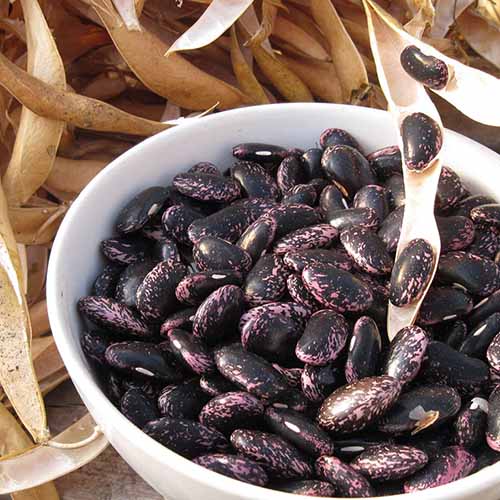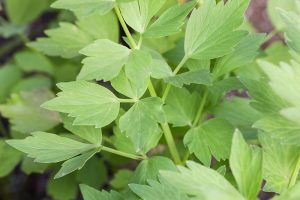Phaseolus coccineus
Loved by gardeners for both their ornamental and edible qualities, scarlet runner beans have bright red flowers that attract pollinators in addition to the edible pods and beans.
Plus, these climbing plants have some advantages over regular pole beans and there are many different cultivars you can grow!
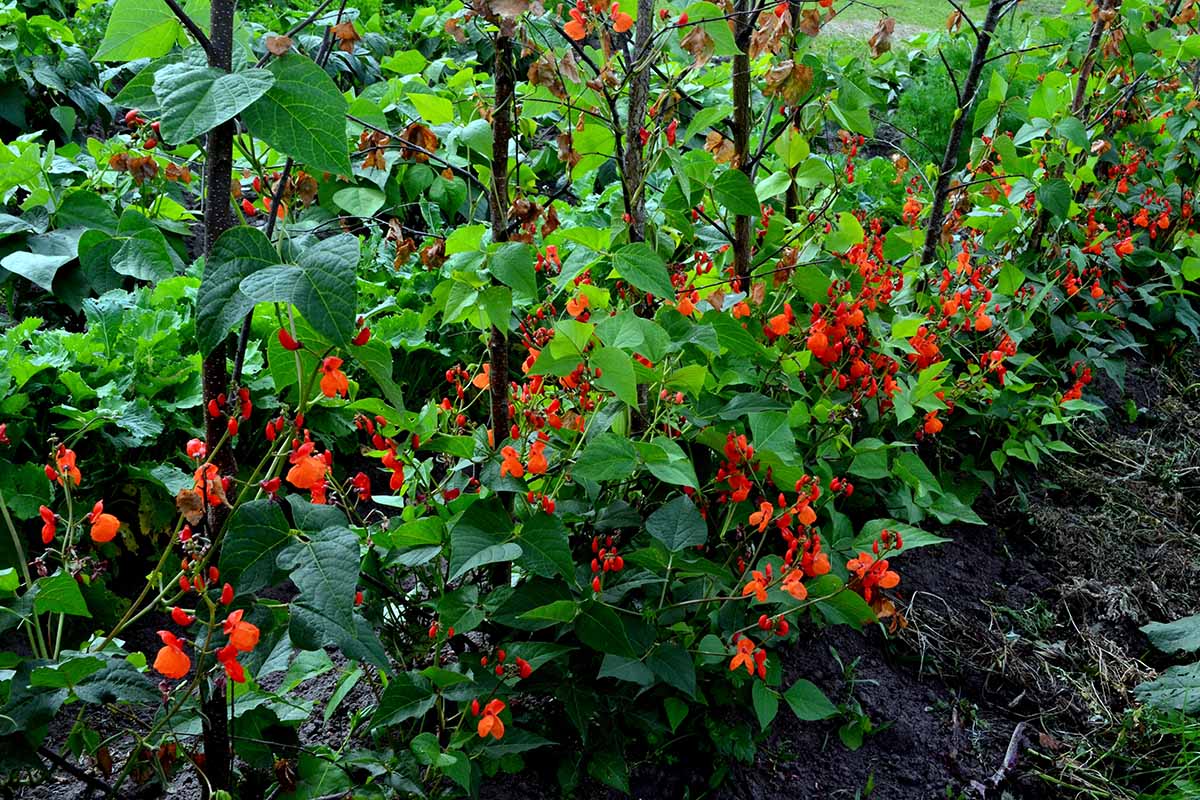
We link to vendors to help you find relevant products. If you buy from one of our links, we may earn a commission.
With bright red blooms, these legumes are a gorgeous annual option for creating climbing screens and covering trellises – and they also have edible pods, seeds, flowers, and roots.
Ready to learn how to grow these red-flowered legumes? Here’s what we’ll cover:
What You’ll Learn
What Are Scarlet Runner Beans?
Scarlet runner beans (Phaseolus coccineus) are vining plants that produce edible green pods and bright red flowers.
Vines can reach seven feet long – or more – and are covered with alternate leaves, each of which is made up of three spade-shaped leaflets. These leaves are edible.
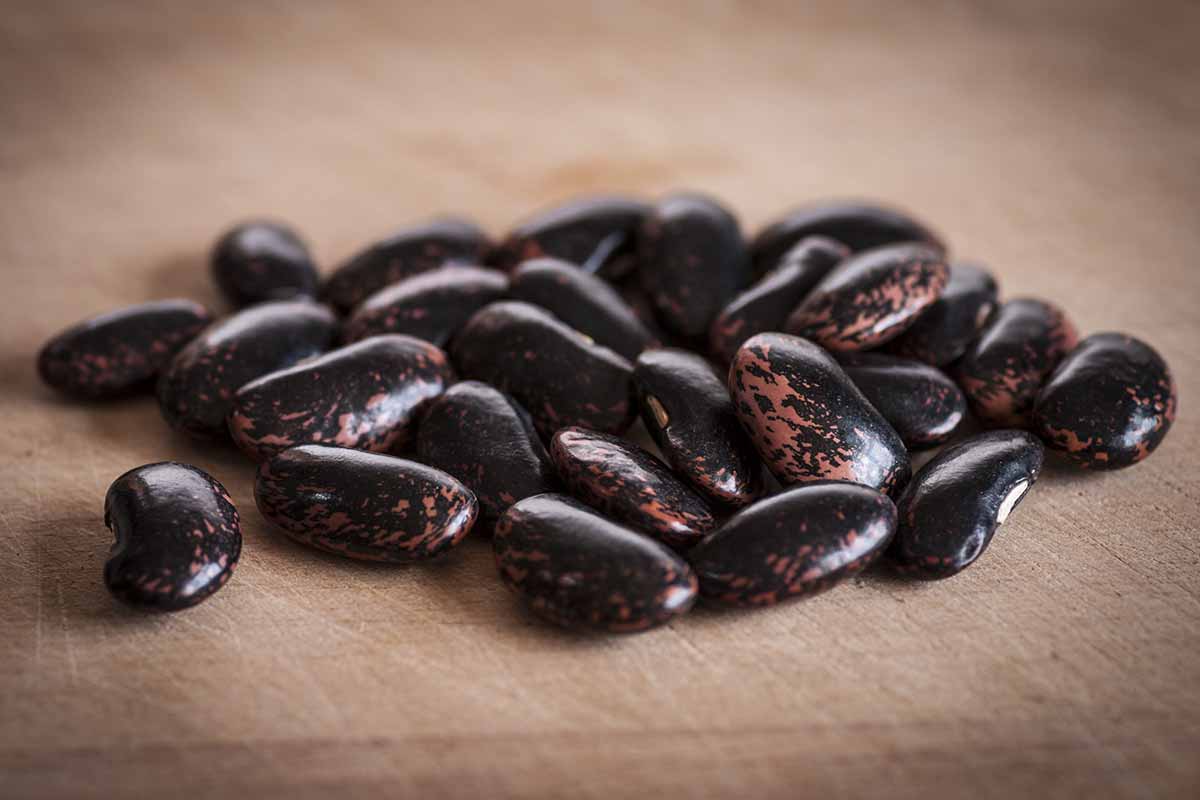
The seeds inside the pods are gorgeous and can be eaten both fresh, when they are shades of purple or lavender, and once they mature to a dark blueish-black hue mottled with purple or light brown. Some varieties have white seeds.
Before pods set, however, the vines are covered with eye-catching blooms in a bright scarlet hue – red with an orangish tint.
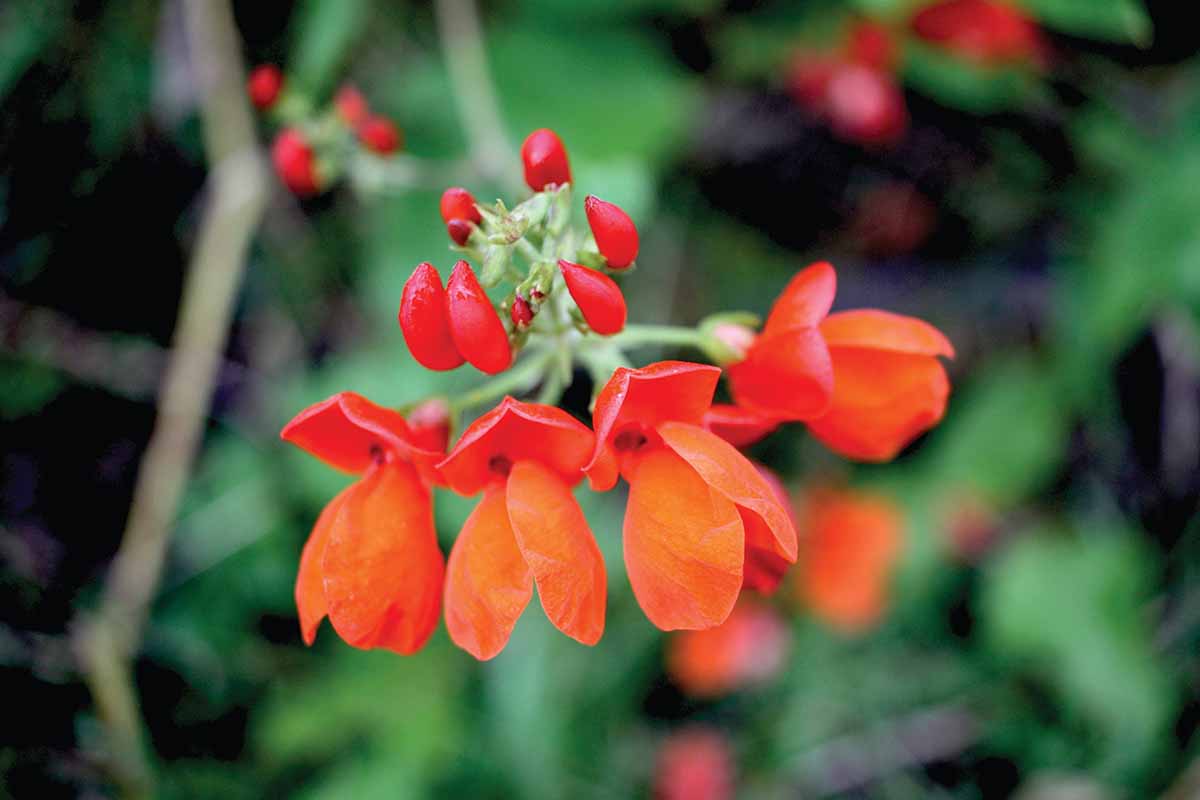
Some varieties have white, pink, or purple colored flowers.
Cultivation and History
P. coccineus is native to Mexico and Central America. It grows in its native range at mid to high elevations where nights are cool, and in a wide range of open habitats.
This leguminous species has been used for food by humans for at least 5500 years, but perhaps as many as 7000 years.
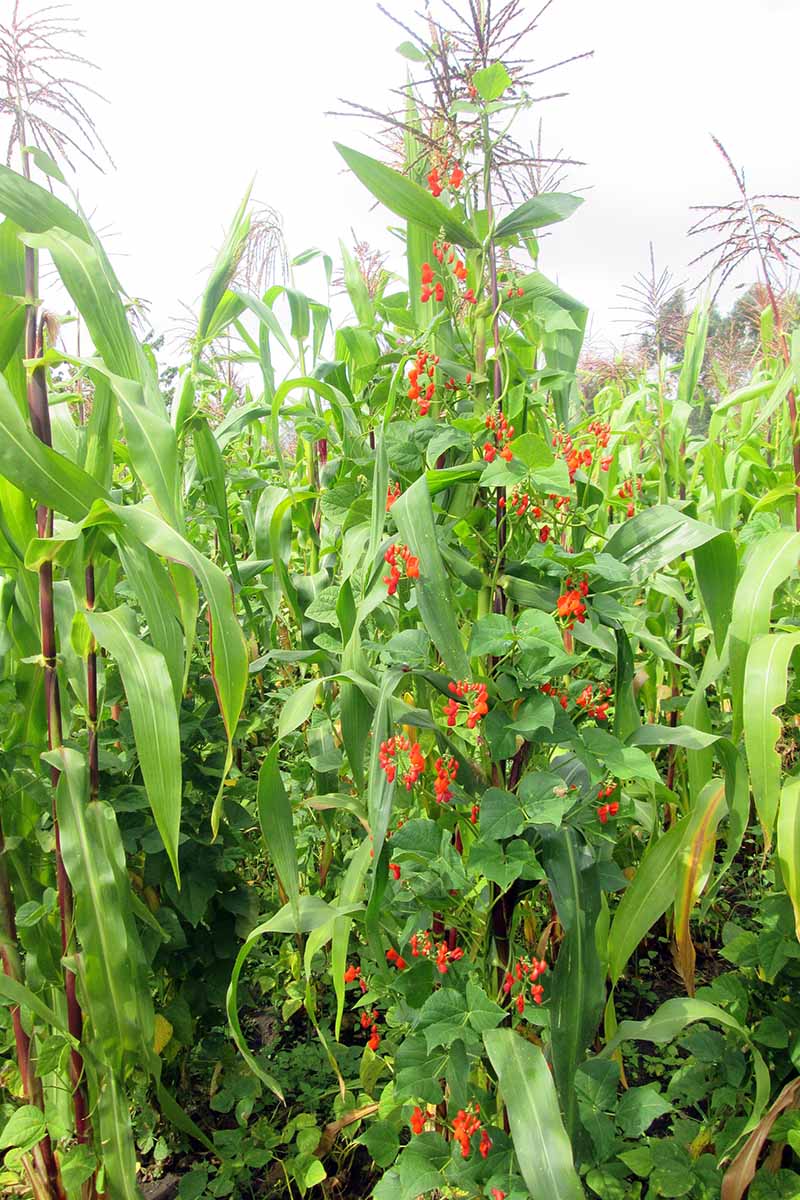
P. coccineus was described taxonomically in 1753, and was grown by Thomas Jefferson at Monticello in 1812.
This species is a member of the legume family, related to such diverse stars of the garden and landscape as green beans (P. vulgaris), redbud trees (Cercis spp.), and fenugreek (Trigonella foenum-graecum)!
In Spanish they are called “ayocote,” and in English these plants are also known as “runners,” “multiflora beans,” and sometimes “butter beans” – though the latter name is most often used for their relative, the lima bean.
Popular in the UK as a garden crop, in the US, scarlet runner beans are more commonly grown as ornamentals than for their edible qualities, and pollinators enjoy their blooms as well.
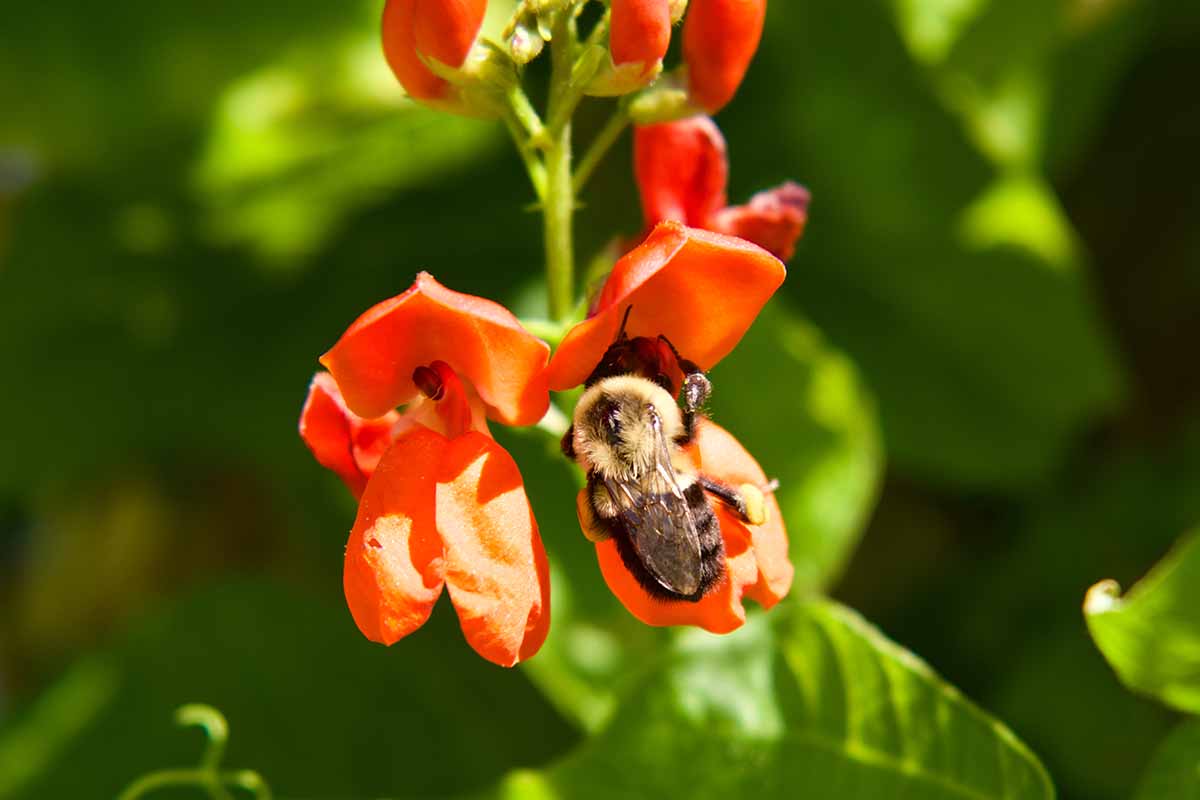
Although many are tempted to grow these plants uniquely for their ornamental blooms, all parts of the plant are edible – pods, seeds, foliage, and tuberous roots!
Whether grown for food or for their beautiful flowers, ayocote can be grown as a short lived perennial in USDA Hardiness Zones 7 to 11, and as an annual in colder zones.
How to Sow Scarlet Runner Beans
The best way to propagate these plants is via direct sowing since these plants have sensitive roots that don’t like being transplanted.
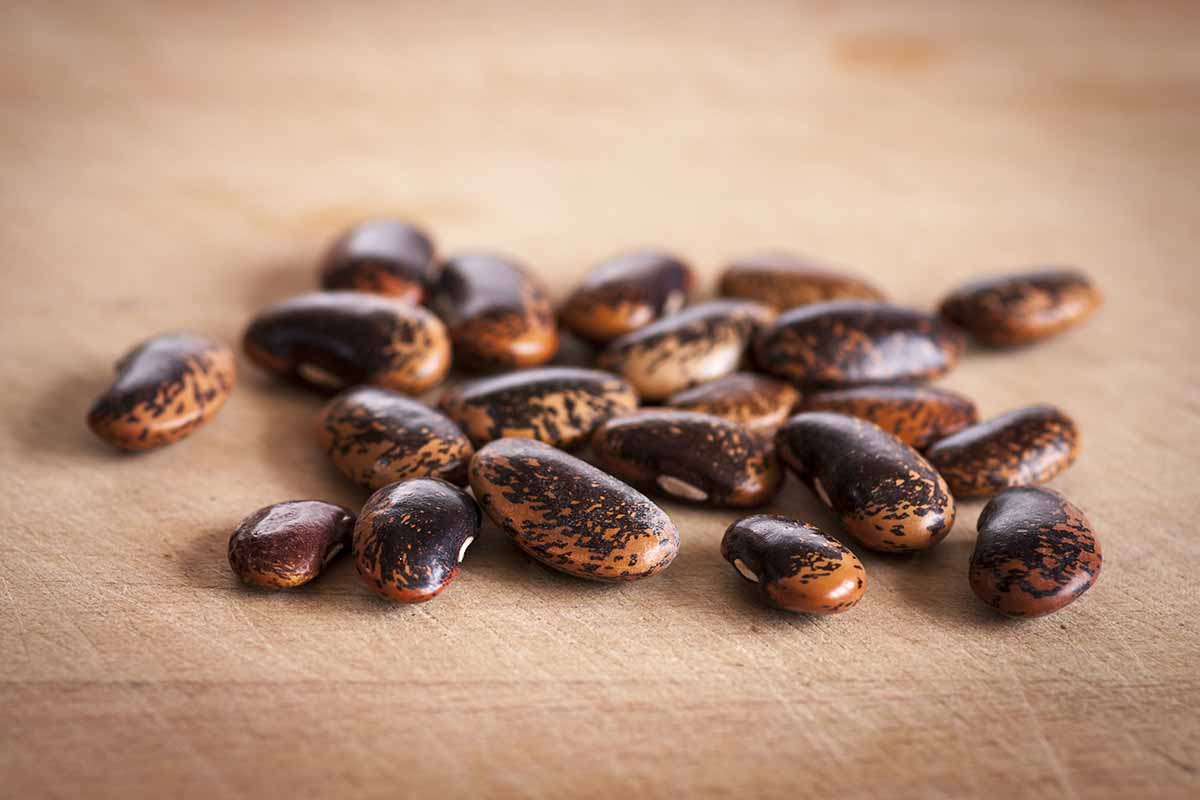
You’ll need to wait until one to two weeks has passed after your last average frost to sow your seeds, since although this crop is tolerant of cool weather, it is not resistant to frost.
First install your trellis, teepee, or other climbing support, and the day before you plan to sow, water the soil so that it’s moist.

In anticipation of sowing, you’ll also want to source out some inoculant for your scarlet runner beans.
Make sure the product you choose contains R. leguminosarum biovar phaseoli.
I recommend Exceed Garden Combination Inoculant, which includes this bacterium and inoculates a wide variety of legumes.
Exceed Garden Combination Inoculant
Exceed Garden Combination is available in one-and-a-half-ounce packets, enough to treat eight pounds of seeds, via High Mowing Organic Seeds.
Apply the inoculant right before you are ready to sow.
Put the seeds in a small bowl with a little water so they are lightly moist, then sprinkle the inoculant over the seeds.
Learn more about using inoculants with legumes in our guide.
If you’re growing scarlet runner beans in a raised bed following the square foot gardening method, sow eight seeds per square foot. If you are planting in rows, sow one seed every six inches.
Planning to sow your scarlet runner beans in containers? Learn more about growing vegetables in containers with our article!
Poke one-inch-deep holes in the soil or growing medium with a dibber, your finger, or a pencil.
Drop one seed into each hole, then close the hole up by squishing the soil together and patting down the surface to ensure good contact.
Water in the seeds after sowing, and keep the area evenly moist while seeds germinate and seedlings become established.
How to Grow Scarlet Runner Beans
This species tolerates cooler climates than varieties of the common bean (P. vulgaris), so if you live at a high elevation and experience cool nights in the summertime, this crop might be very happy in your location!
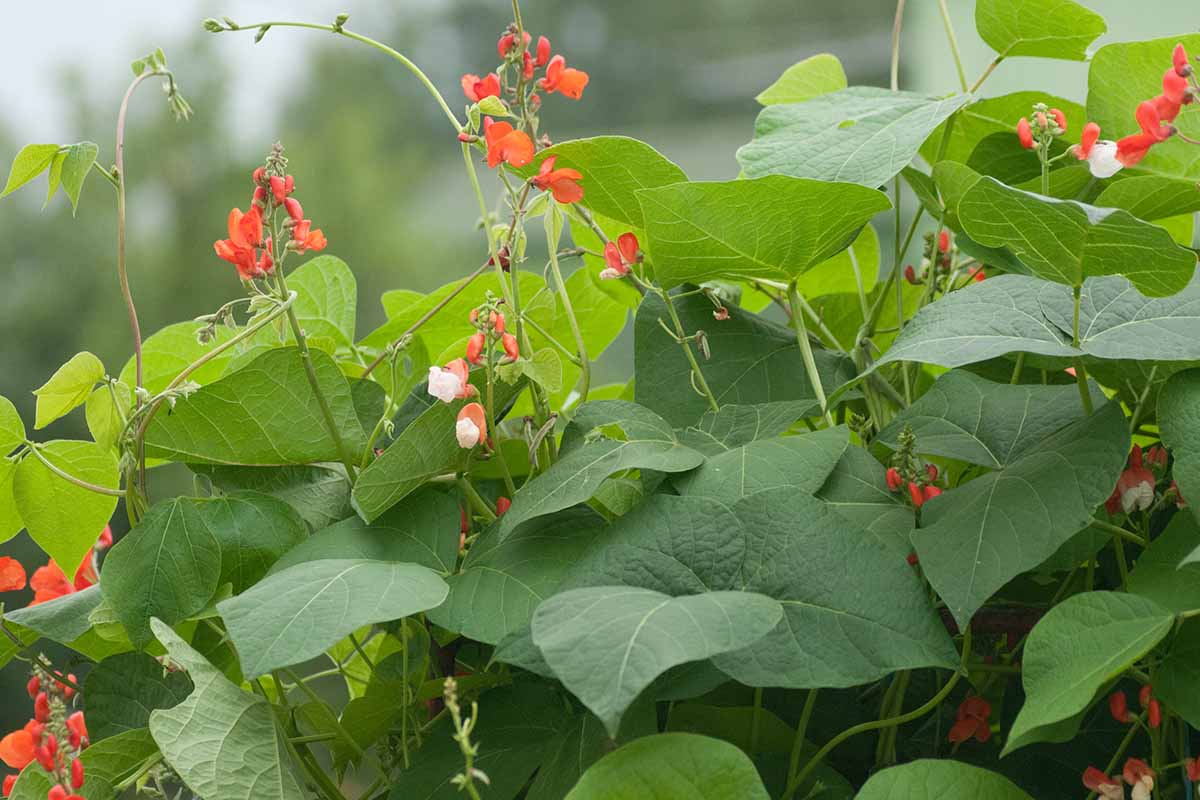
P. coccineus grows happily at temperatures between 60 to 90°F.
However, fruit set can slow down when temperatures rise above 90°F, so don’t expect a bumper crop if you live in a location with several months of 100°F weather during the summer.
If you’re planning to grow your scarlet runner beans on a teepee style trellis, make sure the opening of the teepee is facing north, so that the bulk of the vines are receiving southern exposure.
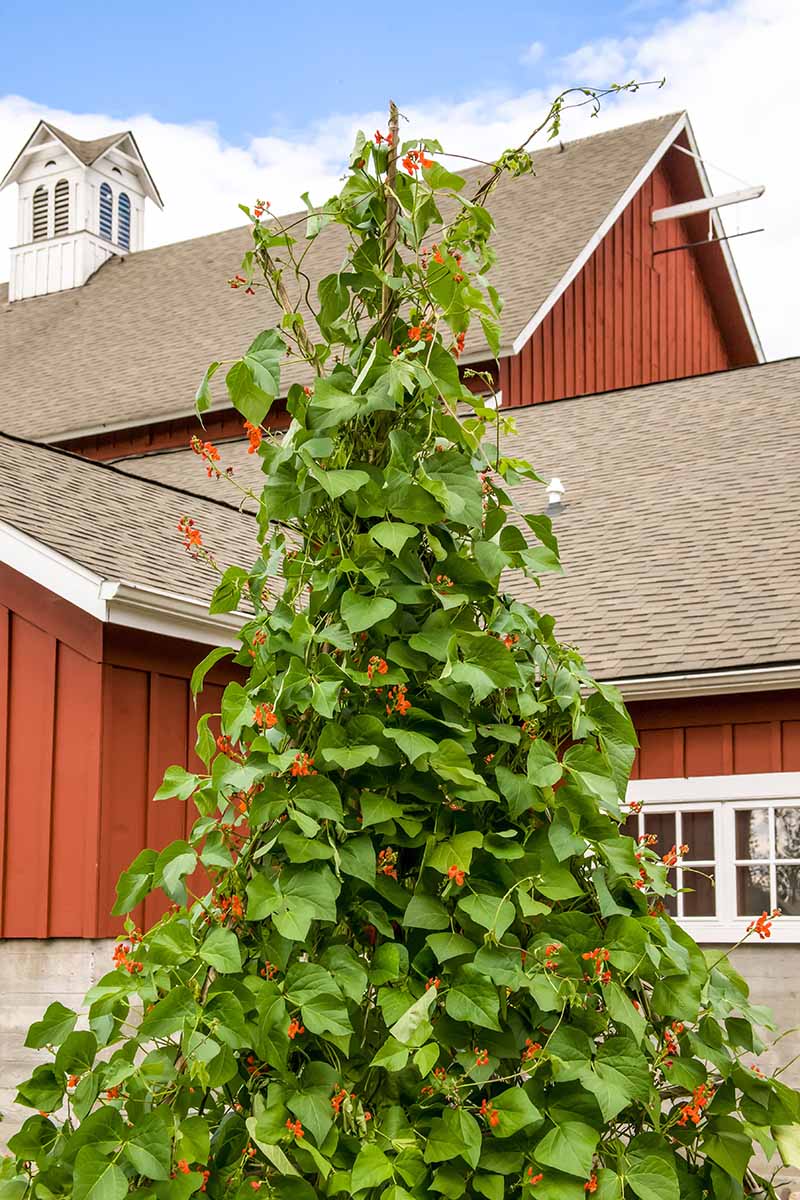
These legumes need full sun, organically-rich, well-draining soil with a pH range of 6.0 to 6.8, and a somewhat moist growing medium – make sure they receive one to one and a half inches of water per week.
Want to grow this crop along with some companion plants? Read up on the best companion plants for beans in our article.
Growing Tips
- Grow in full sun.
- Allow vines to climb a trellis or other support.
- Keep soil moist.
Maintenance
While young plants are getting established, it’s important to stay on top of weeding because weeds can outcompete and smother small seedlings.
If you feel like you spend too much time on that gardening chore, maybe it’s time to learn how to weed more efficiently! Read our article to learn more.
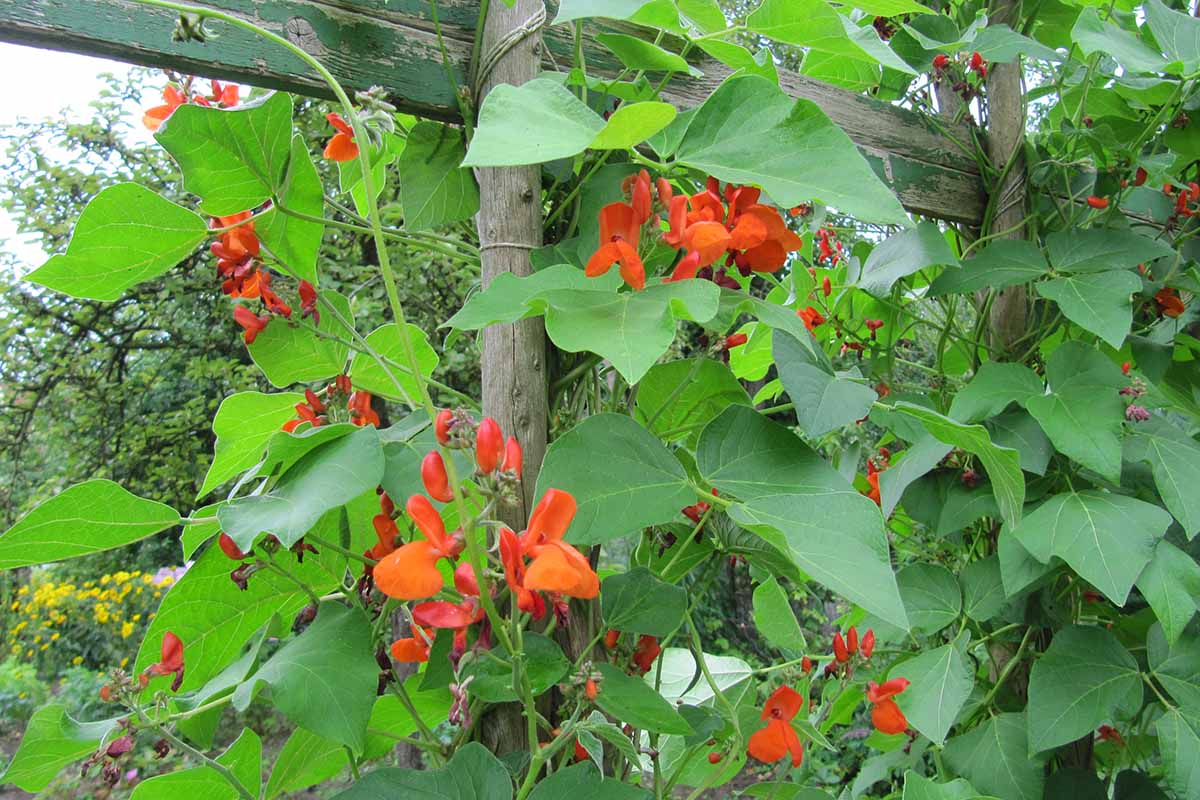
Mulching around the base of plants can help prevent weed competition, while also saving time and resources spent watering.
I favor using flowering ground covers as living mulches around the base of my runner beans, such as sweet alyssum and nasturtiums.
Learn more about mulching in our guide.
To overwinter scarlet runner bean tubers in the ground, don’t dig them up when plants start to die back. Instead, use a pair of pruners to clip the vine back a couple of inches above the soil.
In USDA Hardiness Zones 7 and 8, cover the tubers with a few inches of mulch to protect them from cold winter weather.
Depending on the length of your growing season, these tubers may not grow very big.
If you aren’t trying to overwinter them, throw the tubers into your compost pile at the end of the growing season with your other garden detritus!
Scarlet Runner Bean Cultivars to Select
When choosing which type of scarlet runner bean to grow, you’ll have your pick among several types:
Black Knight
‘Black Knight’ is an heirloom runner variety that produces red blooms followed by black pods.
Seeds are pink when fresh but turn black and lavender as they dry.
Vines reach seven to 10 feet tall, with pods ready to harvest starting in 65 days.

You’ll find packs of 50 ‘Black Knight’ seeds from the Park Seed Store via Amazon.
Lady Di
‘Lady Di’ has the classic red blooms we love these plants for, and produces stringless pods that are tender at six to seven inches long and contain black seeds.
Vines reach 10 feet tall, and mature in 84 to 100 days.
Scarlet Emperor
‘Scarlet Emperor’ is the scarlet runner bean variety you are most likely to come across, known for its brilliant red flowers on vines that reach four to seven feet tall.
Pods contain seeds that are black, mottled with purple, and are ready to harvest in 75 days.
You’ll find ‘Scarlet Emperor’ in a variety of packet sizes available at Eden Brothers.
Managing Pests and Disease
Like other garden legumes, scarlet runner beans can be targeted by pests and diseases, particularly when plants are stressed.
You can help them resist these onslaughts by cultivating the plants in optimal conditions.
Beyond providing this legume with the best sun, soil, and water conditions, interplanting them with companion plants can also help deter pests.
Learn more about the scientifically proven benefits of companion plants in our guide.
Here are the most common pests and diseases to keep an eye out for:
Herbivores
When it comes to wildlife snacking on your runners, you’ll want to be wary of deer.
Deer fencing is the most effective means of keeping these browsers out of your garden – but there are other tricks that will help as well.
Read our article for tips on deer-proofing your garden to learn more.
Rabbits will also gladly snack on your legume crop.
The best way to keep them out is by installing fencing with small openings, such as chicken wire, but there are a few other tactics you may want to try first, which you can learn about in our guide.
Insects
Insects can compromise a legume crop, making harvests inedible. Here’s what to look out for:
Aphids
Aphids are tiny sapsucking insects which can colonize the foliage, where they suck nutrients, weakening plants and sometimes spreading diseases.
You may notice discolored or curling leaves before you notice the aphids themselves, which are usually hiding on the undersides of foliage.
Sometimes all you need to do to get rid of aphids is to spray a strong jet of water from your hose. Repeat this removal strategy daily for about a week, then keep an eye on the foliage. If aphids don’t come back you’re in the clear!
Learn more about how to control aphids here.
Cutworms
You may have admired your scarlet runner bean seedlings sprouting from the soil, only to return a day or two later and notice that these seedlings now look quite odd.
If there’s only a stem remaining where there used to be leaves, or the leaves of the seedling have suddenly vanished, go ahead and blame the cutworms.
These larval caterpillars hang out in the soil, and wait for the sun to go down before coming out from their lairs to chew through the tender stems and leaves of young seedlings.
Luckily, it’s not too hard to stop them, especially since these legume seedlings are fairly large in size.
A collar made from an empty toilet paper roll can be inserted into the soil around each seedling to prevent cutworms from reaching the stems.
Learn more about making cutworm collars as well as other options for controlling these pests.
Mexican Bean Beetles
Mexican bean beetles are a type of ladybug that will munch on plant leaves, leaving foliage skeletonized when infestations are severe.
Unlike the bright red ladybugs that are beneficial insects, these beetles have a yellowish orange to copper brown coloration.

You can prevent problems with these pests by encouraging the presence of natural predators such as green lacewings and beneficial ladybugs.
Learn more about organic control methods for beetles on bean plants in our guide.
Disease
Here’s what to watch for when it comes to diseases:
Anthracnose
If you notice brown or black lesions on vines, foliage, or pods, you may be dealing with anthracnose.
A fungal disease caused by Colletotrichum lindemuthianum, anthracnose can be spread through infected seed or plant debris, especially in warm, damp conditions.
If you find this disease among your crops, remove the affected plants, and don’t grow any types of beans in that same location for another two years.
Even better though – prevent this disease from targeting your legume crops. You can do so by choosing to irrigate at the base of plants instead of with sprinklers, choosing disease-free seed, and rotating crops.
Damping Off
Damping off can kill off young seedlings shortly after they have emerged from the soil. Seedlings sprout, but then start to weaken, look sickly, and wilt, never to recover.
This plant disease is caused by fungal organisms in the soil, so prevention is imperative – take care not to overwater because soggy soil can encourage the growth of these unwanted fungi!
If you are growing your scarlet runner beans in containers, make sure to use clean pots. If they have been used previously, sterilize them before reuse.
Learn more about damping off in our guide.
Powdery Mildew
You’ll recognize powdery mildew, another fungal disease, by the presence of powdery white spores on the surface of the foliage – especially in the parts of the plant shaded by other crops, or at the bases of the plants where sunlight doesn’t penetrate as well.
The best way to control this disease is through prevention. Make sure to plant these legumes in full sun and space plants properly to allow plenty of air circulation.
Read our article to learn more about how to treat powdery mildew organically.
Harvesting
If you want to enjoy eating the pods of your scarlet runner beans, in general, you’ll want to pick them when they are around four inches long, before they reach full length.
Find step by step details for picking young pods in our guide to harvesting snap beans.
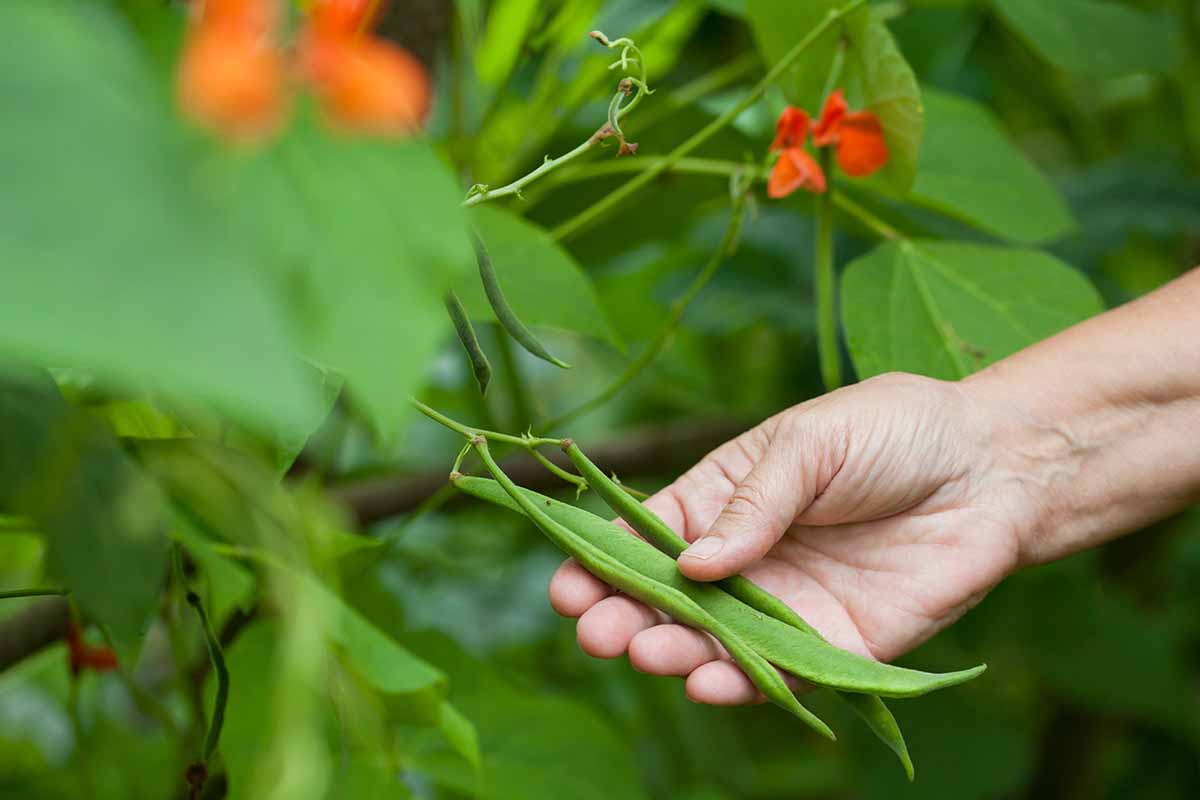
The pods of these legume plants tend to be tougher than those of common beans – and over four inches long they tend to be too tough to chew.
You can allow them (intentionally or not!) to size up and pick them to use as shellies instead of pods– just remove the beautiful pinkish purple seeds from the pods, which you can relegate to the compost.
You can also allow pods to fully mature, drying on the vines, and save the seeds as dry pulses.
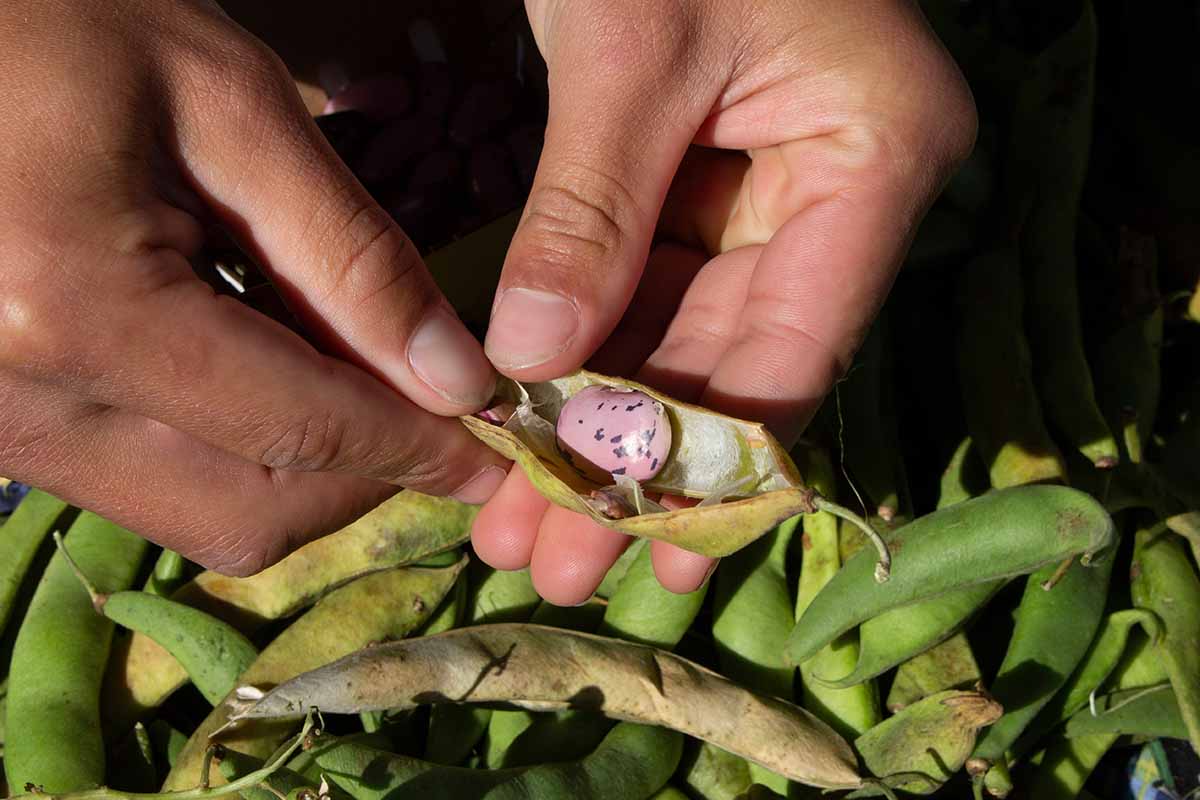
In this plant the young pods, leaves, flowers, and seeds are all edible!
If you want to have a go at eating the leaves, make sure to pick them when small – just be sure to only harvest fewer than a quarter of the total number of leaves on each vine at a time otherwise you’ll be sacrificing your pod harvest.
Feel free to pluck a few of the gorgeous red flowers from the vines to add to salads if you are feeling experimental. Just remember that with every flower you pick, that’s one less pod for your dinner plate.
Preserving
Just like with regular green beans, you have a few options when it comes to preserving the bounties of your harvest.
Young pods can be treated like green beans – they can be canned, dehydrated, frozen, or lacto-fermented.
Interested in using fermentation to preserve your harvest? Check out the recipe for lacto-fermented pickles on our sister site Foodal – just substitute young runner pods for cucumbers.
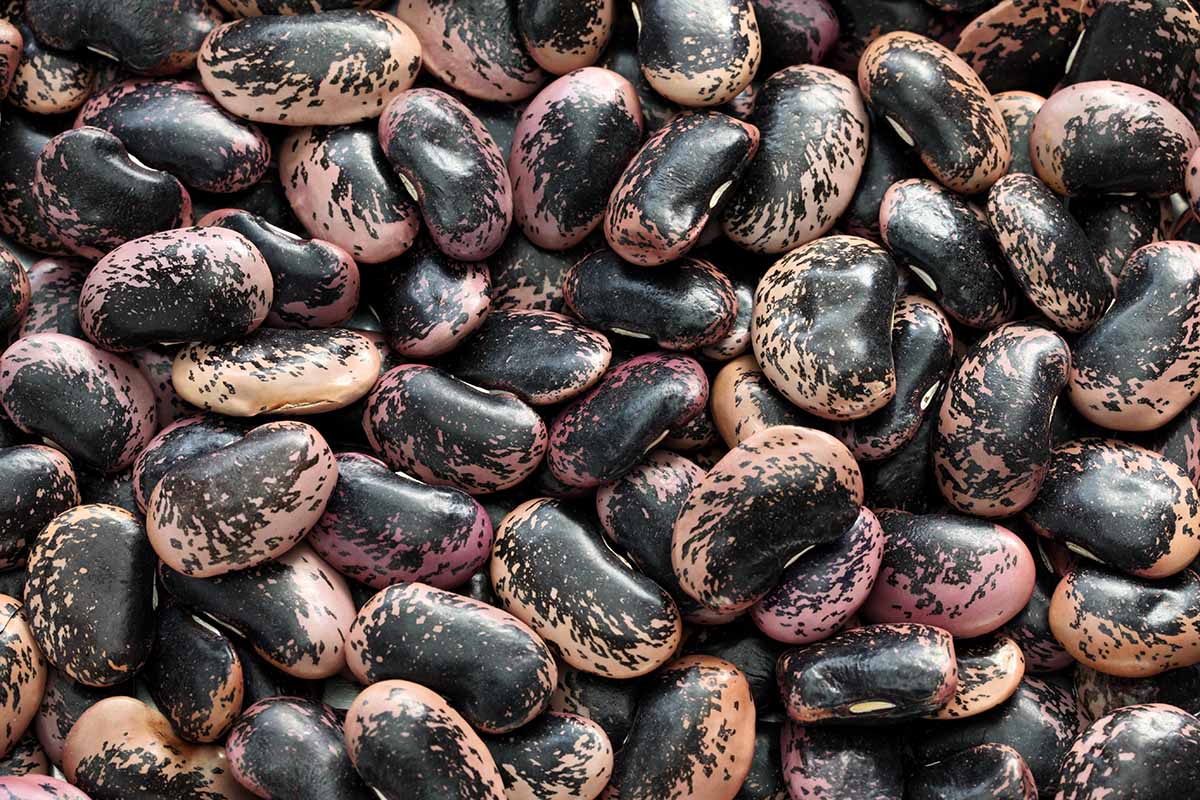
As for storing the mature seeds, make sure they are completely dry before packing them away.
Lay out the harvested, mature seeds on a drying rack in a cool dark place in a single layer.
Check them for dryness by using a fingernail to try to dent a seed. If you manage to make a dent, they need more time drying.
Once dry, store in a jar in a cool, dark location. This method is the same whether you’re saving these pulses as a food staple, or as seeds to grow future crops.
Recipes and Cooking Ideas
Young snaps can be used just like green beans. Need a prep idea?
Check out this recipe for garlic lemon roasted green beans on our sister site, Foodal!
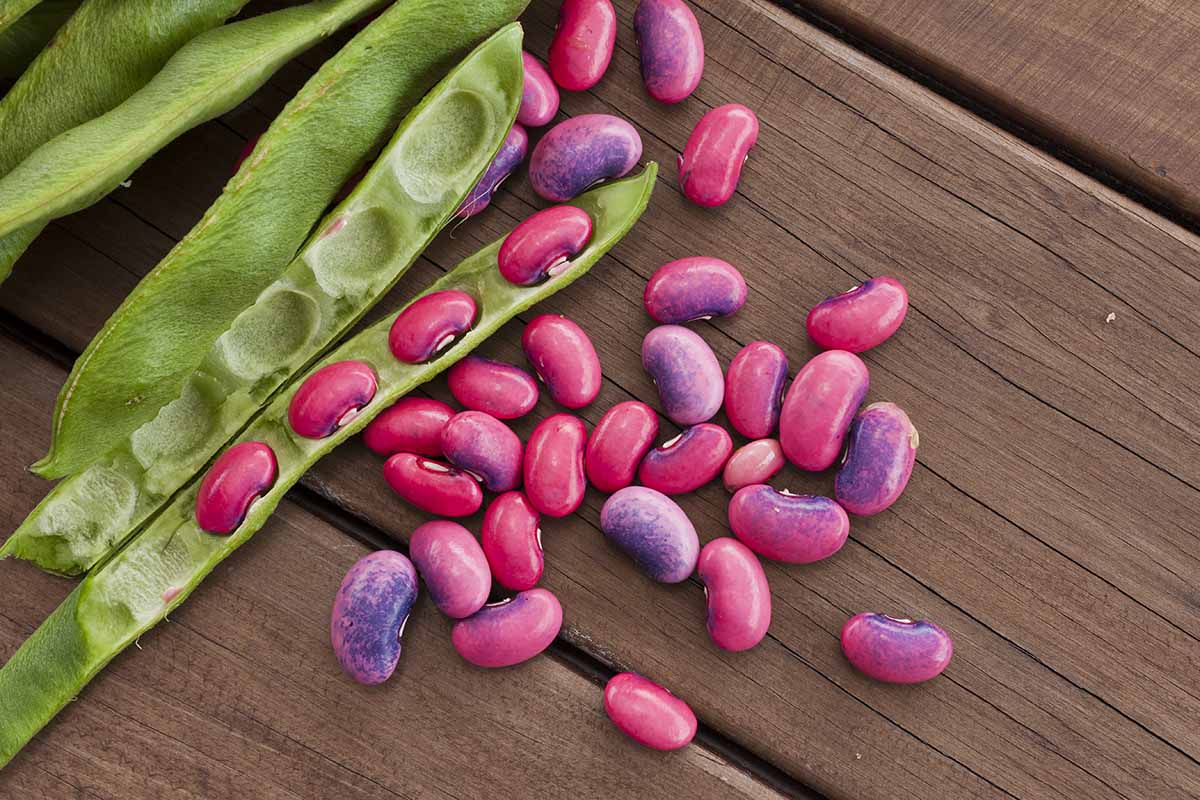
If you’re looking for cooking ideas for the shelled or dry seeds, it’s hard to beat the all-time classic: beans and rice.
This nourishing and simple combo can be dressed up in endless ways – think of it as the little black dress of the culinary world.
Check out this recipe for the best beans and rice, also on Foodal.
Quick Reference Growing Guide
| Plant Type: | Tender perennial vine, grown as an annual | Water Needs: | Moderate |
| Native to: | Mexico, Central America | Tolerance: | Cool weather |
| Hardiness (USDA Zone): | 7-11 | Maintenance: | Low |
| Season: | Summer | Soil Type: | Organically rich loam |
| Exposure: | Full sun | Soil pH: | 6.0-6.8 |
| Time to Maturity: | 65-75 days | Soil Drainage: | Well-draining |
| Spacing: | 6 inches | Attracts: | Bees, hummingbirds |
| Planting Depth: | 1 inch (seeds) | Companion Planting: | Basil, cosmos, marigolds, nasturtiums, sweet alyssum, zinnias |
| Height: | 4-12 feet | Family: | Fabaceae |
| Spread: | 3-5 feet | Genus: | Phaseolus |
| Common Pests and Disease: | Aphids, cutworms, Mexican bean beetles; Anthracnose, bean common mosaic virus, powdery mildew | Species: | Coccineus |
Invite Miss Scarlet to the Garden Party
Now that you know the ins and outs of growing scarlet runner beans, you can confidently include this beautiful plant in your veggie garden or edible landscaping!
Do you have a favorite variety we didn’t mention here? Or do you have any of your own tips you’d like to share with our readers?
Are you using anything creative as a trellis? Let us know in the comments below. And if you have any remaining questions, feel free to drop them there as well.
Want to keep learning about growing beans? We have more reading for you right here:


